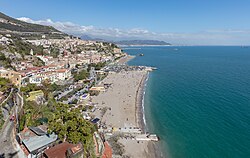You can help expand this article with text translated from the corresponding article in Italian. (January 2024)Click [show] for important translation instructions.
|
Vietri sul Mare | |
|---|---|
| Comune di Vietri sul Mare | |
 View of Vietri sul Mare | |
 Vietri sul Mare within the province of Salerno | |
| Coordinates: 40°40′N14°44′E / 40.667°N 14.733°E | |
| Country | Italy |
| Region | Campania |
| Province | Salerno (SA) |
| Frazioni | Albori, Benincasa, Dragonea, Iaconti, Molina, Raito, San Vincenzo |
| Government | |
| • Mayor | Giovanni de Simone |
| Area | |
• Total | 9.52 km2 (3.68 sq mi) |
| Elevation | 80 m (260 ft) |
| Population | |
• Total | 7,793 |
| • Density | 819/km2 (2,120/sq mi) |
| Demonym | Vietresi (Dialect: Vietraiuli) |
| Time zone | UTC+1 (CET) |
| • Summer (DST) | UTC+2 (CEST) |
| Postal code | 84019 |
| Dialing code | 089 |
| Patron saint | St. John the Baptist |
| Saint day | 24 June |
| Website | Official website |
| Part of | Costiera Amalfitana |
| Criteria | Cultural: (ii)(iv) |
| Reference | 830 |
| Inscription | 1997 (21st Session) |
| Area | 11,206 ha (27,690 acres) |
| Buffer zone | 11,857 ha (29,300 acres) |
Vietri sul Mare is a comune (municipality) in the province of Salerno, in the Italian region of Campania. It is situated just west of Salerno, separated from the Port of Salerno by only a harbour wall. [4] The town is known for its polychrome ceramics, a tradition since at least the 15th century, [5] and is considered to be the gateway to the Amalfi Coast. [6]
Contents
Its frazione of Albori is one of I Borghi più belli d'Italia ("The most beautiful villages of Italy"). [7] The main landmark of Vietri sul Mare is the Church of St. John the Baptist, a late Neapolitan Renaissance style building with a high bell tower. There are numerous buildings displaying ceramics, including the Museo Provinciale della Ceramica in the nearby village of Raito.[ citation needed ]


